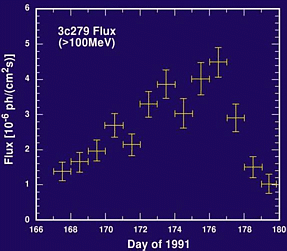In any case, an enormous amount of energy is required to
generate and sustain the jets seen in GRO J1655-40. Since it is much closer
to home than the distant quasars - about 10,000 light years as opposed
to about 1,000,000,000 light years - scientists infer that it is far less
luminous and fills a much smaller volume of space than a quasar. This means,
among other things, that it evolves more rapidly - on time scales of days
rather than decades or longer! As such, GRO J1655-40 affords scientists
a unique opportunity to study how jets are formed and how they evolve over
time. With the combination of nearly continuous monitoring of the gamma-ray
emission provided by BATSE, and frequent observations in the radio, evidence
linking the accretion process and jet formation has been revealed for the
first time! It was found that jet-ejection episodes followed gamma-ray
"flares" by 5-10 days. Because of the larger distances to quasars, the
analogous effect could take decades to observe. Combined radio, optical,
ultraviolet and x-ray studies of GRO J1655-40, and about a half-dozen other
transients believed to contain black holes, have provided an unprecedented
wealth of information. Additional transients are likely to occur within
the lifetime of Compton, and undoubtedly, more surprises will be
forthcoming.
Quasars: Cosmic Engines
Surprises have been business as usual for Compton. In the first
few weeks of the mission, the instruments pointed to the Virgo region to
observe the only active galaxy ever seen to shine at gamma-ray energies
greater than 100 MeV - a quasar called 3C 273. An ordinary galaxy mainly
shines with the visible light emitted by its billions of stars. But many
galaxies are bright at other wavelengths: radio, infrared, x-ray, or even
gamma-ray. The energy from such an active galaxy may arise from bursts
of star formation, a collision with another galaxy, or perhaps even a massive
central black hole. When active galaxies lie at extreme distances, their
apparent size is so small they appear like a star. |
In this case, they may be known as a quasi-stellar
object, or quasar. Despite the fact that quasars lie in the outer reaches
of the universe, they are still detectable by our telescopes. This implies,
given their great distances, that they are among the most energetic phenomena
in the universe. The observation of 3C 273 surprised scientists because
the bright gamma-ray source they expected to see was several degrees away
from the position of 3C 273! It turned out that they were in fact detecting
3C 279, a similar type of quasar. 3C 273 was weakly detectable in the same
image but the bright emission from an unanticipated source set the tone
for the Compton mission. The variability of the gamma-ray quasars
are shown by the light curve of 3C 279 during this period. The rise in
intensity over a few days and then the flux plummeting back down is not
atypical of gamma-ray quasars. Starting with the unexpected detection of
gamma rays from the object known as 3C 279, EGRET has detected over 60
additional |
gamma-ray quasars, some at distances of a billion
light years from Earth. Many of them are highly variable, extremely powerful
cosmic accelerators. For example, the observed flux from 3C 279 implies
a total luminosity over 10,000 times that of the total luminous output
of our entire galaxy, assuming the emission is isotropic, that is, uniform
in all directions. Most scientists however, now consider this very unlikely
and believe that the emission is "beamed", or directed into a narrow cone.
The quasars that EGRET detects are the ones that are fortuitously directed
towards us. Like the galactic object GRO J1655-40, the variability of the
gamma-ray quasars provide scientists the opportunity to carefully monitor
emission at many wavelengths, providing a unified picture of the gamma-ray
source. The ever- changing gamma-ray sky makes this approach necessary. |
